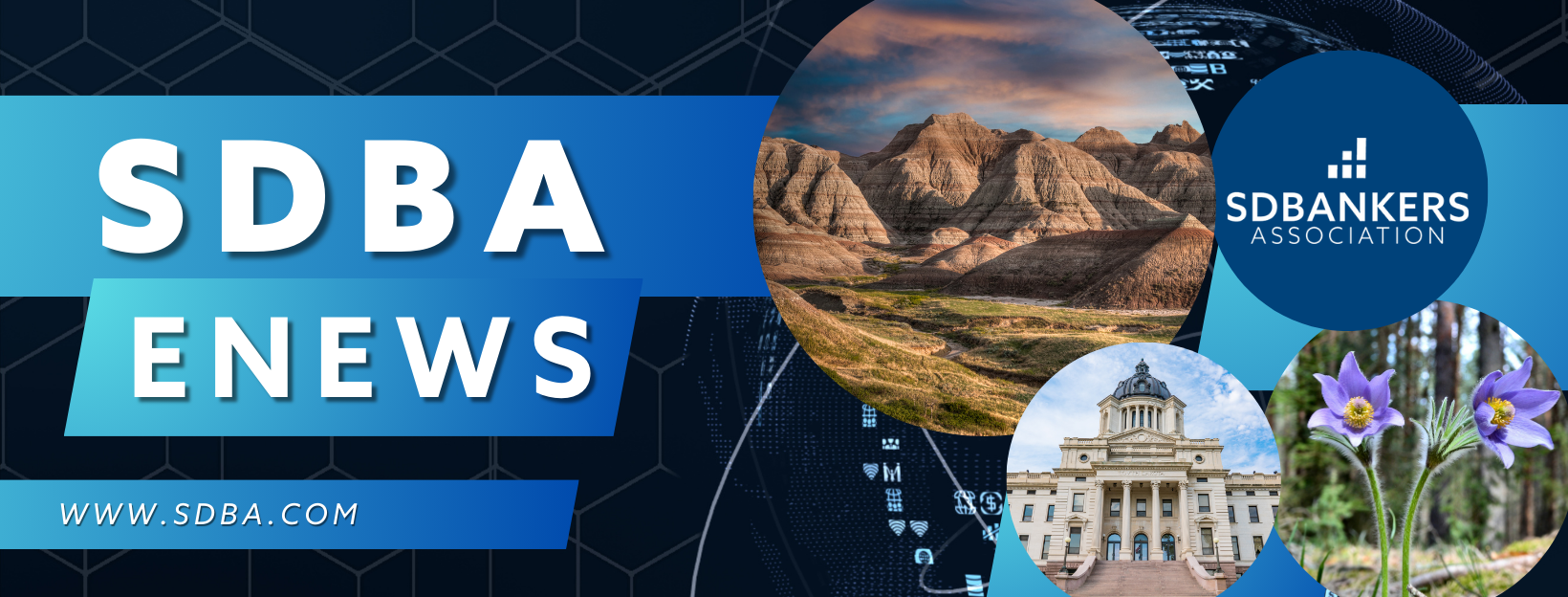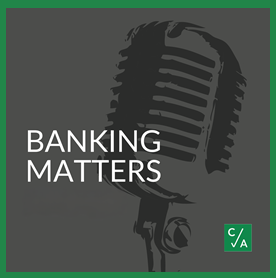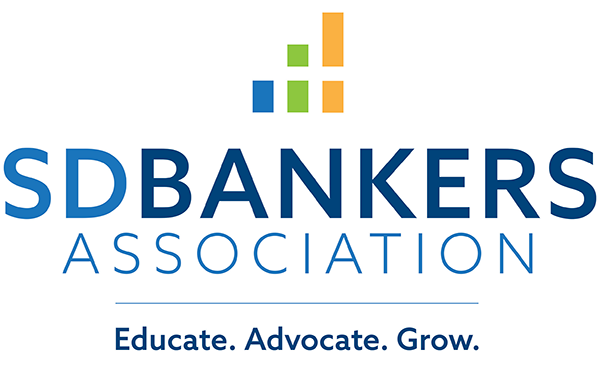|

News
SDBA Updates
SDBA Events
Online Education
Banking Matters Podcast

The FDIC board today voted to start indexing certain regulatory thresholds and to delay the compliance date for its revised requirements regarding the use of the agency’s name and logo. It also elected to hold the designated reserve ratio for the Deposit Insurance Fund at 2%.
Under the final rule, the FDIC will update certain agency thresholds to reflect the cumulative inflation that has occurred since their initial implementation date or the last time they were adjusted. The rule also establishes automatic adjustments every two years based on the Consumer Price Index and allows the FDIC to adjust thresholds in intervening years if the cumulative change in CPI exceeded 8% since the most recent adjustment.
The rule will take effect Jan. 1, 2026. Also, banks currently subject to part 363 requirements but will no longer be subject to the requirements under the updated thresholds. The rule sets an Oct. 1 effective date for future threshold adjustments.
Signage requirements
The FDIC last year adopted new signage requirements that were scheduled to take effect on March 1, 2026. The agency has since proposed to make further changes to the requirements, which have yet to be finalized.
With the proposal still outstanding, the board voted to push back the compliance date to Jan. 1, 2027, given “that institutions may need to make investments in advance of the compliance date.”
Deposit Insurance Fund
The Federal Deposit Insurance Act requires that the FDIC set the designated reserve ratio for the DIF before the start of each calendar year. The DRR has been set at 2% since 2011, and at today’s meeting, the board voted to maintain it at that level in 2026, as recommended by agency staff.
ABA responds
At the same meeting, the FDIC board voted to revise supplementary leverage ratio standards for the largest banks and advanced a proposal to change the community bank leverage ratio. In a statement, American Bankers Association President and CEO Rob Nichols thanked the board for taking several steps to improve the bank regulatory framework.
“Today the FDIC took an important step toward a more stable and predictable regulatory framework by finalizing a rule that indexes certain key bank thresholds so they remain aligned with growth,” Nichols said. “ABA encourages other regulators and Congress to adopt approaches that prevent regulatory drift and keep supervisory attention focused where it is most needed.”
As for FDIC signage, Nichols said ABA welcomed the new compliance date.
“As the number of players in the financial services marketplace increases, it’s important for Americans to understand which financial institutions are FDIC insured, and which are not,” he said. “This extension will help prevent unnecessary burden for banks and enhance clarity for bank customers as the FDIC considers further changes.”
ABA Banking Journal: Banking agencies advance proposed revisions to community bank leverage ratio
November 25, 2025
 The banking agencies today advanced proposed interagency rulemaking to expand the eligibility criteria for the community bank leverage ratio, or CBLR, while also extending the grace period for banks that elect to use it. The banking agencies today advanced proposed interagency rulemaking to expand the eligibility criteria for the community bank leverage ratio, or CBLR, while also extending the grace period for banks that elect to use it.
The proposal would lower the CBLR requirement from 9% to 8%, which would allow an additional 475 community banks to use the framework if they choose to do so, according to a board memo. It would also expand the time banks can remain in the CBLR framework without meeting the qualifying criteria, from two quarters to four quarters. The Federal Reserve and the Office of the Comptroller of the Currency also are advancing the proposal.
The CBLR was created in 2019 as an optional framework for community banks to reduce their regulatory burden by removing the requirements for calculating and reporting risk-based capital ratios. Banking agencies estimate that roughly 84% of community banks qualify for the CBLR but only 40% have elected to use it — a figure that has barely budged in recent years.
At the meeting where the FDIC board voted to approve the change, FDIC Chairman Travis Hill said the proposed changes seek to encourage more community banks to use the CBLR.
“The U.S. economy and communities across the nation benefit tremendously from the presence of local community banks,” Hill said. “Today’s action is one of many to promote the long-term viability of the community bank model while continuing to ensure that banks maintain adequate levels of capital and operate in a safe and sound manner.”
In a statement, American Bankers Association President and CEO Rob Nichols called the FDIC decision “an important change that will allow a much broader range of community banks to utilize this simplified capital framework.
“The CBLR adjustment will allow community banks to do even more to support their local economies,” he said.
Full Article
ABA Course: Strengthen Your Fraud Awareness and Decision-Making!

Human Factors in Fraud Prevention Suite
The ABA is excited to announce a new curriculum added to their training catalog, “Human Factors in Fraud Prevention Suite”. Fraud prevention starts with people. This suite explores how human behavior, decision-making and workplace culture shape fraud risk — and how bankers can play a critical role in preventing it.
Member Registration - $95
Fraud prevention starts with people. This suite explores how human behavior, decision-making and workplace culture shape fraud risk — and how bankers can play a critical role in preventing it. These three microlearning courses, plus a GO Huddle, will be part of the ABA Banking Foundations license catalog, in the Workplace Essentials topic and available only as a suite.
Non-Member Registration: If your organization is not a member of the ABA, but you would like to register, email us at [email protected] and we’ll get you a non-member link!
CISA News: Zoomers are officially worse at passwords than 80-year-olds
November 18, 2025 | Connor Jones
They can probably set up a printer faster, but look elsewhere for cryptography advice
Gen Z can get off their digital high horses because their passwords are no more secure than their grandparents'. According to NordPass, there is no real difference between the security of those used by the younger generation and their supposedly tech-illiterate ancestors. In fact, the security company's analysis of passwords this year shows the most common choice among those born in 1997 and younger was weaker than almost every other generation… by one digit.
"12345" was the top choice among Zoomers this year, whereas the far superior "123456" was preferred by Millennials, Gen X, and Boomers. So much for the "digital native" title often handed to the youngest generation.
And while there were a few more "skibidis" among the Zoomer dataset compared to those who came before them, the trends were largely similar. Variants on the "123456" were among the most common for all age groups, with that exact string proving to be the most common among all users – the sixth time in seven years it holds the undesirable crown.
Some of the more adventurous would stretch to "1234567," while budding cryptologists shored up their accounts by adding an 8 or even a 9 to the mix. However, according to Security.org's password security checker, a computer could crack any of these instantly. Most attackers would not even need to expend the resources required to reveal the password, given how commonly used they are. They could just spray a list of known passwords at an authentication API and secure a quick win.
NordPass said: "Despite significant efforts over the years to educate users about cybersecurity through awareness campaigns, our data shows little improvement in widespread password hygiene and security habits. "With the number of breach cases growing each year, the problem remains as prevalent and dangerous as ever, suggesting that current approaches fail to drive meaningful change."
One glimmer of hope from the global data, taken from recent breaches and dark web repositories, was that the use special characters is on the rise. On the list of the 200 most common passwords of the year, 32 had some sort of special character – usually an @ – up from just six the year before. NordPass said the @ character was often used in place of the letter A. Think "P@ssw0rd" and the like.
There were also no muscles being pulled when it comes to setting passwords in professional environments because "admin" and variations on that theme were also among the most common passwords in use presently. According to NordPass, it was the second most used password globally, and the top choice in countries such as Australia, Canada, Germany, Ukraine, the United Arab Emirates, the UK, and the US.
Surely, this many organizations are not choosing "admin" in the current cybersecurity environment, right? We asked NordPass whether this was a sign of seriously poor password choices or if it was a case of default credentials not being changed (which isn't necessarily better). A spokesperson said it was difficult to say conclusively what's going on, but other common default passwords, such as "welcome" and the classic "password," also featured heavily in the top-200 list.
As any good purveyor of password managers would do, NordPass recommended users get one, and use it to generate and store complex, unique strings for each login, as well as using multi-factor authentication for extra peace of mind. ®

2026 Advertising & Sponsorship Planning Guide

The SDBA’s 2026 Advertising & Sponsorship Planning Guide is now available! This guide is your full media kit for advertising:
• SDBANKER Magazine
• Weekly SDBA eNews
• BankHer Bulletin
• Emerging Leader Newsletter
• SD Bank Directory
• BankSquawk Podcast
• Classified advertising
It also provides information on sponsorship and exhibit opportunities at SDBA events throughout the year. The SDBA encourages business partners to view the guide to see how they can get involved in the SDBA in 2026.


2026 SDBA IRA Basics Webinar
Wednesday, January 7, 2026 | 9:00 a.m. - 3:00 p.m. CST | Zoom
This course is designed as a “very basic” IRA seminar as it is designed to build a solid IRA foundation. The seminar will start with the differences between a Traditional and a Roth IRA, and then discuss how to set up a new IRA and the eligibility rules to contribute to an IRA. The biggest topic for people new to IRAs to discuss is the moving of money from one financial institution to another. This involves IRA transfers and rollovers, plus the direct rollovers from a qualified plan. Discussion will go thru the 13 exceptions to taking money out of an IRA before age 59.5 to avoid the penalty tax, and how RMD is calculated in a traditional IRA. There will be an introduction into death distributions. Finally, we will cover how to take money out of a Roth IRA.
Details & Registration
Beacom School of Business: Speed Networking 2026
Wednesday, January 28, 2026 | 2:00-4:00 p.m. CST
The Beacom School of Business - Career Success Center invites you to attend our Speed Networking 2026 event on Wednesday, January 28 from 2-4pm. This is a great opportunity for you to come on-campus and network with our students, especially May 2026 graduates and summer internship seekers. There is no cost to attend.
We will use a speed networking format where employers will have a round table set up and small groups of students will rotate to tables in 10 minute intervals until about 3:30pm. The last 30 minutes of the event will be an open networking reception for you and students to visit more in depth. During your 10 minutes you are welcome share information about your company and any full-time, part-time, or internship opportunities that you may have available. At the event you are more than welcome to collect student contact information to keep in touch with them. Also, feel free to bring any recruitment materials and promotional items you’d like to share with students.
Would you be interested in attending this event? If so, please RSVP today as there are limited spots available. Registration is will close on Monday, January 19th.
Speed Networking Registration
2026 SDBA State Legislative Day
February 11, 2026 | Pierre

The SDBA State Legislative Day is an opportunity to stay up-to-date on both state and federal legislation which could affect the banking industry, visit with state legislators and constitutional officers, and make sure our industry is heard. The day includes an SDBA Legislative Committee meeting, lunch and featured speakers including the Governor if scheduling allows. The day also includes programming for emerging bank leaders.
Details & Registration
Sponsorships
If you are interested in being a sponsor for the 2026 SDBA State Legislative Day, learn more HERE.
Online Education

Participating in learning opportunities outside the bank can be challenging. Take advantage of the SDBA's extensive selection of webinars and on-demand training to enhance your banking expertise directly from your computer.
GSB Online Seminars
OnCourse Learning
SBS Institute
ABA Training
Banking Matters Podcast

Navigating Reputation Risk and Banking Compliance
Learn how to put compliance management solutions from Compliance Alliance to work for your bank, by contacting (888) 353-3933 or [email protected] and ask for our Membership Team. For timely compliance updates, subscribe to Bankers Alliance’s email newsletters.
SDBA eNews Archive
Advertising OpportunityLearn more about sponsoring the SDBA eNews
Questions/Comments
Contact the SDBA at 605.224.1653 or via email
|



 The banking agencies today advanced proposed interagency rulemaking to expand the eligibility criteria for the community bank leverage ratio, or CBLR, while also extending the grace period for banks that elect to use it.
The banking agencies today advanced proposed interagency rulemaking to expand the eligibility criteria for the community bank leverage ratio, or CBLR, while also extending the grace period for banks that elect to use it.





